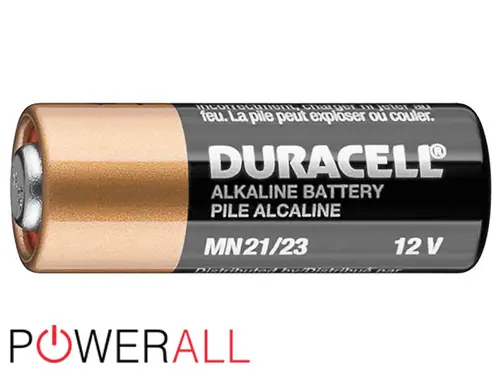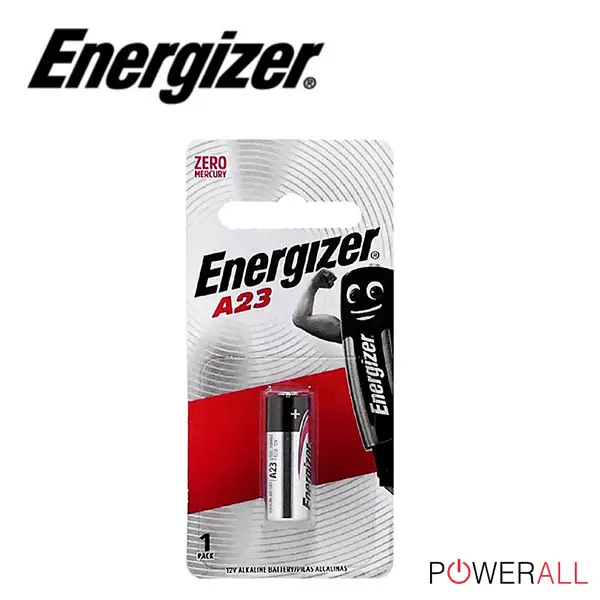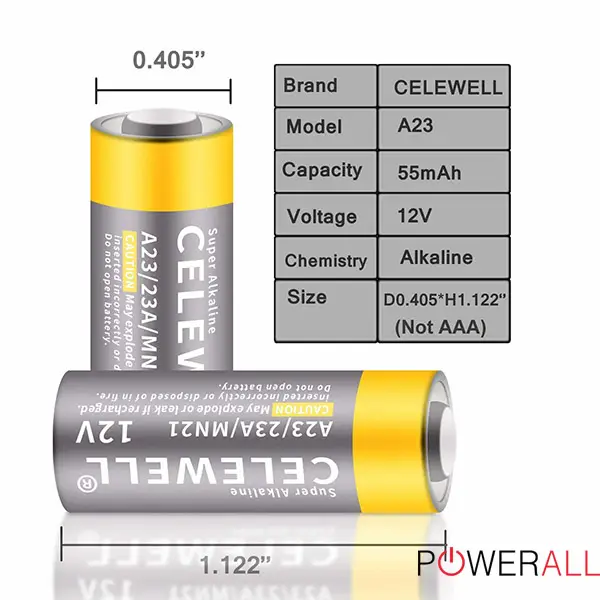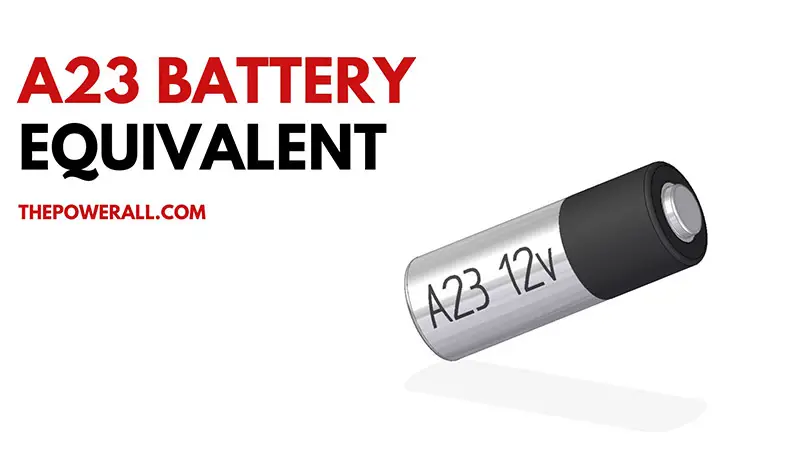Except for manufacturers that adopt a naming standard, some run wild in the choice of labels. This contributes to the long list of labels of the same product and confuses users.
Chances are you’re in a similar situation with 23A 12V battery equivalents, wondering which are its other names. Scroll down to list all of them.
Battery A23 Equivalents In Details
Like other batteries, the A23 possesses a long list of labels determined by the manufacturer. The IEC standard assigns another name to 8LR932, while the ANSI standard defines 1811A. Besides, you can find other terms considered A23 equivalents, including LR23A, A23G, V23GA, L1028, MN21, 8LR23, 23A, 23AE, A23S, GP23A, and LRV08.
A23 comes in a cylinder shape with a length of 28.5 mm, a diameter of 10.3 mm, and a weight of 8 grams. Its name is inspired by the dimension of about two-thirds of AAA batteries.

Regarding chemistry, A23 belongs to the category of non-rechargeable alkaline batteries. This battery type often appears in small electronic devices such as Bluetooth headsets, video game controllers, cameras, keyless vehicle entry systems, etc.
An A23 battery pack consists of eight alkaline cells called the LR932. Each produces a nominal voltage of 1.5V and a cut-off voltage of 0.9 – 1.0V. Thus, a single set creates a nominal voltage of about 12 and a cut-off voltage of 6 – 8 volts.
Its nominal capacity falls between 50 – 60 mAH. The actual performance depends on a wide range of factors, such as temperature, lifespan, or discharge current.
For example, you can warm up “dead” batteries in minutes. The voltage then spikes, and your items gain an extra life. However, it is only temporary, and you should carry out a battery replacement as soon as possible.
Popular Manufacturers Of 23A Equivalents
Duracell

Duracell A23 is among the most popular battery brands due to its good performance. This non-rechargeable battery delivers a rated capacity of 60 mAh as measured by a 20 kΩ resistor/load at 20°C down to 6.0 volts. At room temperature, it operates as follows:
| Load | Initial current | Total working hours |
| 46kΩ | 0.22 mA, down to 6 volts | 315 – 320 hours |
| 20kΩ | 0.52 mA, down to 6 volts | ~ 130 hours |
| 10kΩ | 0.96 mA, down to 6 volts | 60 – 62 hours |
| 470Ω | down to 8.25 volts | 40-42 minutes |
| 15mA | down to 6.0 volts | 5s/55s On/Off |
Additionally, its self-discharge rate is 10% annually at 20°C. Storage temperature ranges from 5°C to 30°C, while operating temperature extends from -10°C to +60°C.
This option works out for most high-load, low-load, or pulsed applications. Therefore, you can easily find it in electronic equipment such as computers, game consoles, or medical devices.
Energizer
The Energizer A23 battery, with non-rechargeable alkaline cells, enters the market as a leading Duracell competitor. Its nominal capacity reaches 50 mAh tested with a 20 kΩ resistor at 21°C down to 6.0 volts.

The Energizer’s typical discharge duration progresses as follows:
- Down to 8.8 volts in 92 hours
- Down to 7.2 volts in 98 hours
- Down to 6 volts in 100 hours
The higher the discharge current, the lower the capacity. For example, the power drops to about 43 mAh at 5 mAh and plummets to 26 mAH at 15 mAh. On the bright side, the output voltage remains above 9 volts for about 90% of the operating time. These features make it ideal for powering multiple devices.
A23 Vs. Other Similar Batteries In Comparison: Are They Interchangeable?
A23 Vs E90
The A23 and N-cell (E90) batteries possess relatively similar physical dimensions. The former is 10.3 x 28.5 mm, while the latter is 12 x 30.2 mm. Another similarity is that both belong to the wide category of alkaline batteries.
Given this common ground, most battery compartments made for N-cells can accommodate the A23 with ease. In comparison, only some, not all, A23 compartments work with the E90.
One important thing to note is that these two deliver different nominal voltages. The A23 produces 12 volts, while the N-cell battery only responds to 1.5 volts. Hence, contact issues are bound to happen if you try to swap back and forth.
The significant deviation in voltage often leads to fire incidents and internal injuries to equipment. One thing is for sure – these two are not interchangeable.
A23 Vs. AAA
Both batteries share the same diameter (10.3 and 10.5 mm), although the length of the A23 is only two-thirds of triple-A (28.5 and 44.5 mm). Unexpectedly, the set of two AAA batteries (10.5 x 89 mm) stacked on top of each other creates the same dimension as the bank of three A23 (10.3 x 85.5 mm).
However, this does not mean you should randomly install them into any compartment. Leaving the difference in the number of cells aside, the most important problem arises from the voltage gap.
While the sum of two AAA batteries produces 3 volts, the setup of A23 with the same physical size outputs up to 36 volts. In short, you should never think of using them as substitutes for each other.
A23 Vs ⅔ AAA
When the size of triple-A is reduced by a third, which gives birth to ⅔ AAA, is it equal to A23 in size? The quick answer is YES. Specifically, depending on the models, the latter features a dimension of 10.5 x 29-30 mm – a twin version, right?
Still, the incompatibility of this pair lies not only in voltage but also in classification. The 2/3 AAA battery is rechargeable and belongs to the Nickel Metal Hydride (NiMH) group. Its nominal voltage is small, about 1.2 volts, suitable for compact solar lights or electrical equipment.
A23 Vs A27
These two are nearly identical in both size and internal construction. The dimension of A27 is 8.0 x 28.2 mm, or in other words, its diameter is slightly smaller than A23.
Regarding the technical structure, both contain eight cells – LR932 and LR732/LR632. As a result, they produce an equal nominal voltage of 12 volts. The only dissimilarity comes from the double larger capacity of the A23 compared to the A27 (50-60 mAh vs. 20-22 mAh) due to the wider internal volume.
Given these specifications, it is easy to find out that the A27 can fit inside the battery compartment of the A23. However, the mismatched diameter may cause contact problems for moving devices.
In contrast, some A23-powered applications have a plastic adapter that works well for the A27. Users can interchange these two options, but the A27 tends to run out faster than the remaining if the equipment operates frequently.
Buying And Using Advice For LR23A Battery Equivalent
If you are considering buying an MN21 23 battery equivalent, look at the device’s specs, and it will give you the answer. Important information includes amp-hour and voltage. A compatible choice helps to save energy and optimizes the power and lifespan of both device and battery.

It is not a big problem if you plan to install the A23 for low-voltage devices, such as, entry remotes, flashlights, or smart keys. Most devices work at their best as long as the battery fits with the compartment.
Some people do not believe that pets or children can swallow these shiny objects because their size is much larger than micro batteries. It is no coincidence that battery manufacturers pack A23 cells in a “pet and kids safe package.” Despite the inconvenience for the user to take out the product, safety should still be a priority.
A23 does not contain heavy metals, but always be alert. Its ingredients can produce explosives and cause injury if it comes in contact with bodily fluids. Once you catch anyone swallowing an A23 or any other battery, contact emergency services immediately and perform first aid as directed.
FAQs
Are A23 And 23A Batteries The Same?
Yes. Both are just different labels for the same types of alkaline batteries. If you are still in doubt, check the chemical composition, dimension, voltage, and actual capacity.
How Long Does An A23 Battery Last?
This type usually lasts 2-3 years, while some models have a life expectancy of up to 5 years. Many factors affect its lifespan, especially the specified device.
How Do I Know The A23 Battery Is Dead?
Any battery undergoes aging after a period of use because of energy loss. Regarding A23, the voltage drop to 6 volts means the dead state, which means very little charge left or loss of energy holding. Some obvious signs of this final stage are capacity drops or frequent power outages that cause equipment interruptions.
Conclusion
Swapping between A23G battery equivalents is safe because they are essentially identical. But safety issues arise for the interchangeable use of the A23 and its closely related battery labels. In essence, they are the same battery size, not the output. Such incompatibility often leads to the risk of fire and damage to the equipment.










0 Comments